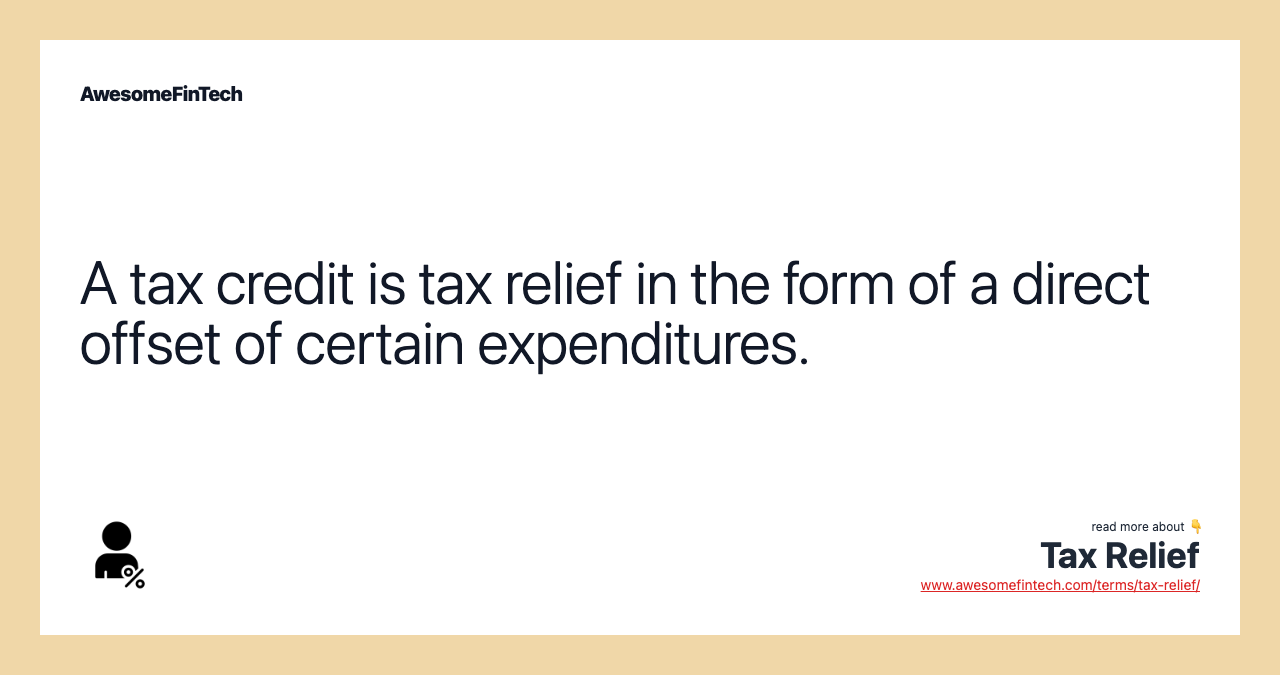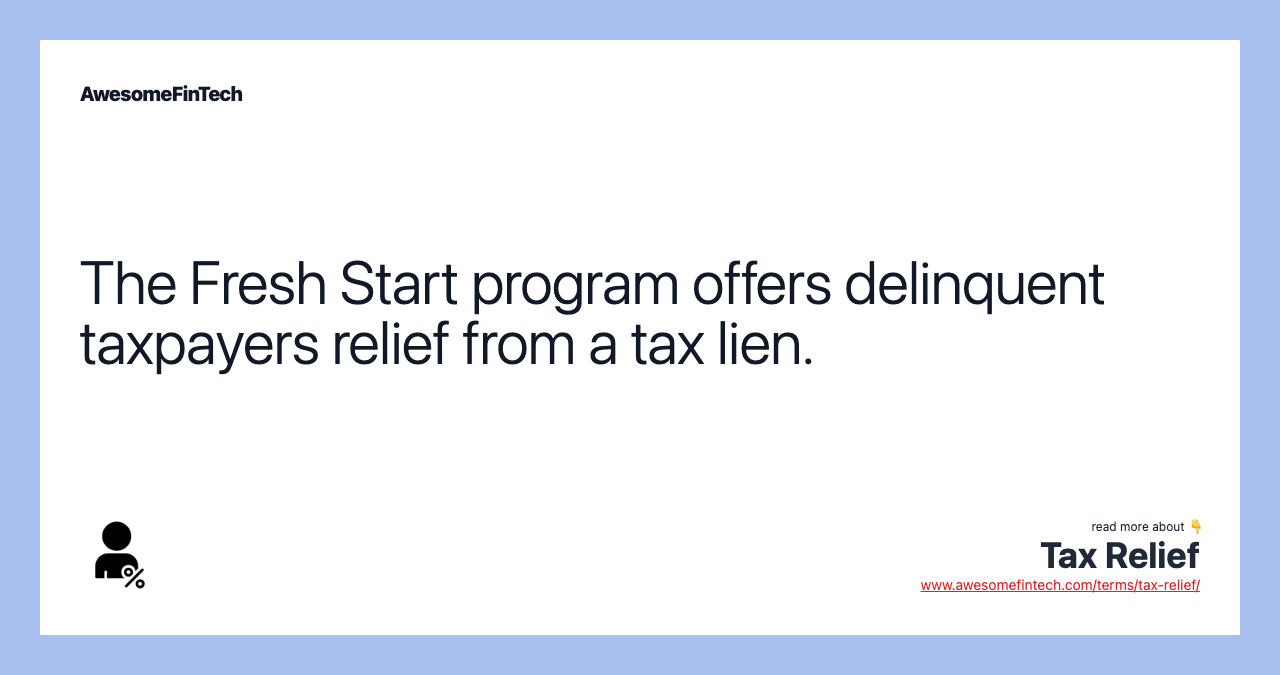Tax Relief
Tax relief is any government program or policy initiative designed to reduce the amount of taxes paid by individuals or businesses. The IRS has a program called Fresh Start that offers a number of options for taxpayers to settle outstanding tax debts, often for a percentage of the original liability. The agency can provide a tax relief arrangement to help people pay the reduced tax amounts over time and avoid a tax lien. A tax credit is another form of tax relief, one that provides greater savings than a tax deduction does. Exclusions classify certain types of income as tax-free or as tax relief, reducing the amount that a taxpayer reports as gross income. A tax deduction that allows individuals to deduct expenses certain expenses (such as home mortgage interest) is one form of tax relief.

What Is Tax Relief?
Tax relief is any government program or policy initiative designed to reduce the amount of taxes paid by individuals or businesses. It may be a universal tax cut or a targeted program that benefits a specific group of taxpayers or bolsters a particular goal of the government.
The Child Tax Credit, for example, benefits American parents of minor children. A tax credit for purchasers of energy-efficient vehicles furthers the goal of greater U.S. energy independence and cleaner air.



Understanding Tax Relief
An individual or business entity typically gets tax relief through deductions, credits, or exclusions, and occasionally by the forgiveness of a tax lien.
The policy goals of the U.S. government can often be tracked through the many additions and amendments made over time to the federal tax code. Americans are encouraged to save for retirement by making tax-delayed contributions to a retirement savings account. They are discouraged from raiding those accounts by tax penalties imposed on early withdrawals.
Even the history of natural disasters can be read through the tax code. Hurricane victims may be allotted some form of tax relief to offset the damage to private property suffered when a hard-hit region is declared a disaster area. Victims of the 2018 California wildfires were able to declare casualty losses not covered by private insurance on their income tax returns.
Tax relief is intended to reduce the tax liability of individuals or businesses. Tax relief is also often designed to provide assistance to a particular group of people or to bolster a cause.
Tax deductions
The reduction of taxable income using legal deductions is a form of tax relief. The most commonly used federal tax deduction is the one for home mortgage interest.
Tax relief often targets specific taxpayers, such as those bearing unexpected costs due to a hurricane or a wildfire.
A tax deduction reduces the taxable income of a taxpayer. If a single filer’s taxable income for the 2020 tax year was $75,000, that person would owe around $12,500 in federal income tax. However, if the person qualifies for an $8,000 tax deduction, taxes will be based on $75,000 - $8,000 = $67,000 in taxable income. The person's federal income tax would then decrease to around $10,500.
Tax credits
A tax credit is another form of tax relief, one that provides greater savings than a tax deduction does. A tax credit is directly subtracted from the individual's total amount of tax owed after all deductions are made.
For example, say a taxpayer has finished itemizing deductions (or has taken the standard deduction) and the bill amounts to $3,000. If the person is also eligible for a $1,100 tax credit, the final tax bill will be $1,900.
This type of tax relief is often described as a tax incentive because it reimburses taxpayers for expenditures that the government deems worthwhile. For example, the American Opportunity Tax Credit and the Lifetime Learning Credit programs allow tax credits to be taken by people who enroll in postsecondary education programs.
Tax exclusions
Exclusions classify certain types of income as tax-free or as tax relief, reducing the amount that a taxpayer reports as gross income.
In some cases, income that has been excluded for tax purposes is not recorded on the return. In other cases, it is recorded in one section of the return and then deducted in another section.
For example, the value of company-paid health insurance is not recorded on an individual tax return, and employees do not pay income tax for that cost. Their employers, on the other hand, deduct the cost as a business expense.
Tax debt forgiveness
The IRS has a program called Fresh Start that offers a number of options for taxpayers to settle outstanding tax debts, often for a percentage of the original liability. The agency can provide a tax relief arrangement to help people pay the reduced tax amounts over time and avoid a tax lien.
Related terms:
Additional Child Tax Credit
The Additional Child Tax Credit was the refundable part of the Child Tax Credit. The refundable credit was revamped under the Tax Cuts and Jobs Act. read more
American Opportunity Tax Credit (AOTC)
The American Opportunity Tax Credit is a credit for expenses incurred in the first four years of post-secondary education. read more
Business Expenses
Business expenses are costs incurred in the ordinary course of business. Business expenses are deductible and are always netted against business income. read more
Child and Dependent Care Credit
Child and dependent care credit is a nonrefundable tax credit for unreimbursed childcare expenses paid by working taxpayers. read more
Child Tax Credit
This $2,000-per-child credit covers children under 17; $1,400 is refundable. In 2021, it's $3,000 for under 18s ($3,600 under 6) and fully refundable. read more
Dependent
A dependent is a person who entitles a taxpayer to claim dependent-related tax benefits that reduce the amount of tax that the taxpayer owes. read more
Earned-Income Credit (EIC)
The earned-income credit (EIC) is a tax credit in the U.S. that benefits certain taxpayers who earn low incomes from work in a particular tax year. read more
Educator Expense Deduction
The educator expense deduction is a tax break for teachers and other education professionals for up to $250 in out-of-pocket expenses. read more
Foreign Tax Credit
The foreign tax credit is a nonrefundable tax credit for income taxes paid to a foreign government as a result of foreign income tax withholdings. read more
General Business Tax Credit
The general business tax credit is the total value of all the individual credits to be applied against income on a tax return. read more